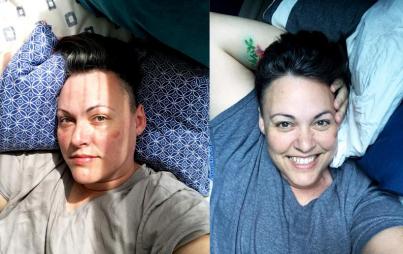
Get ready for the Lifetime movie . . .
The story of a 40-something, attractive blonde who once cheered for the Baltimore Ravens, Molly Shattuck, engaging in a sexual relationship with a 15 year-old boy has captivated the nation. It's the ultimate tale of seedy downfall: the bubbly former Homecoming Queen gets indicted on counts of rape and unlawful sexual conduct with a minor because she can't control her inappropriate lust.
It is also, apparently, really hot.
Here's a sampling of comments from one representative article about the case:
"Niceeeeeeeeee" (South Park Voice)
I'm not sure that I understand why this ended - did this stupid 15 year old get tired [of] oral sex from an NFL Cheerleader ?
oh, man: how come i never got molested by ahottie [sic] like her
The presumption here, of course, is that the teen wasn't a victim at all, but rather the lucky beneficiary of a hot chick's advances. This is a common belief, and a deeply gendered one; if a 40 year-old man was sexual with a 15 year-old girl, it's difficult—if not downright impossible—to imagine similar "aw yeah, get it!" responses (and, of course, for good reason).
There are also some dangerous stereotypes lurking beneath this presumption. And they're not, well, very "niceeeeeee" at all.
Of Gender Roles And Statutory Rape
Here's the problem with presuming men can't be sexually victimized: It's rooted in the underlying assumption that they have all the sexual agency. Here's the problem with presuming women can't be sexual abusers: It's rooted in the underlying assumption that they have no sexual agency.
In a report from the University of Michigan Feminist Studies journal, Carolyn E. Cocca, further expounded on the gender biases at play:
"I find that while much of the discourse still categorizes statutory rape with a male victim as abuse, the 'older woman' perpetrator is more often described as a manipulative or mentally ill seductress while the 'older man' perpetrator is usually likened to an abusive predator, doubly outside the bounds of society by being homosexual as well. Such language maintains the boundaries of traditional gender roles: the older woman is constructed as an almost sympathetic aberration of her gender who tries to obtain love by seducing a young male, while the older man is seen simply as a sexual aggressor and is therefore more universally excoriated for his behavior."
We very much see this assessment reflected in reactions to the Shattuck case; to quote one commenter who helpfully analyzed her: "She is clearly manic—leads to hypersexuality." The idea? She's not an aggressor, but simply crazy and unable to manage her lust—and sympathetically so.
The legal system, too, has reflected these entrenched ideas about gender roles. Originally, statutory rape laws were gender-specific, punishing only a male who had sexual intercourse with a female not his wife under the age of consent. In an article from the Fordham Urban Law Journal, Kay L. Levine noted:
"Legal scholars writing for the past fifty years—a time period that brackets the Supreme Court's decision in Michael M. v. Superior Court of Sonoma County—implicitly and nearly universally assume that statutory rape defendants are male and their victims female."
As of 2000, all 50 states had made their laws gender-neutral, but this historical legal precedent has helped to establish double standards that persist today. In 2009, it was reported that a 17-year-old boy had sex with his 14 year-old girlfriend and was charged with a felony for statutory rape; when a 17 year-old girl in the same town committed the same crime, she was charged with far less.
It's important to note here that statutory rape involving female victims is far more common: about 95% of statutory rape incidents involve a female victim and a male offender. But this doesn't mean the other 5% of cases should be treated as somehow less "criminal," simply because the genders are reversed. (It does, though, pose another important question: Why are cases of older men getting sexual with younger women less frequently covered by the media?)
These stats also belie how young men may be less inclined to report abuse because of lingering stigmas; as the comments make clear, there's a presumption that men should want sex with a woman—no matter the circumstances. Yet according to one study, 43% of young men have had an unwanted sexual experience and, in most cases, the sexual coercion was perpetrated by a woman.
In the end, downplaying sexual assault in the hands of a woman doesn't do the gender equality movement any favors—especially since that woman just so happens to be a pretty blonde cheerleader. Could it be that people assume she's simply too delicate, too weak, for true sexual dominance or moral depravity?
The struggle for equality isn't just about equal rights, but also equal accountability, and an abuser is an abuser—man or woman.






